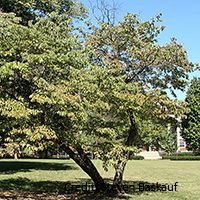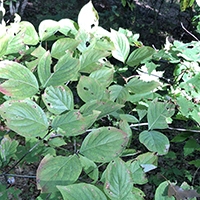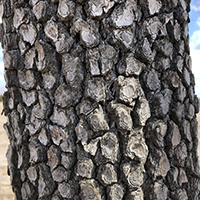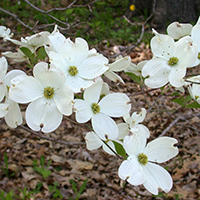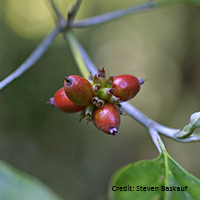What eastern flowering dogwood looks like
Size and shape
- Reaches 10 metres high.
- Trunk up to 20 centimetres in diameter.
Leaves
- Green, oval leaves turn red in fall (8 to 15 centimetres long).
Bark
- Greyish brown.
- Separated into plates similar to alligator hide.
Flowers
- Clusters of 20 to 30 small yellow-green flowers surrounded by 4 white petal-like bracts.
Fruit
- Shiny, red, fleshy fruit that grow in clusters.
Where eastern flowering dogwood is found
Eastern flowering dogwood is a species at risk in Ontario found in the Carolinian zone of Southern Ontario from west of Toronto to the Michigan border.
Find out what we are doing to protect eastern flowering dogwood by reading the recovery strategy.
What you need to know to grow eastern flowering dogwood
- Moisture: grows best in moist, well-drained soil.
- Soil: grows best in rich, sandy or loamy soils.
- Shade: grows best in partial shade.
- Cautions:
- Dogwood anthracnose affects the leaves and is caused by an invasive fungus. Infection begins in leaves that are shaded or in damp areas. Leaves develop light brown spots. The crown of the tree, and eventually the whole tree, will die as infection spreads. No measures currently exist to control the spread of dogwood anthracnose.
Benefits and uses of eastern flowering dogwood
Wildlife benefits
Eastern flowering dogwood fruits are a food source for many species, including:
- crows
- robins
- northern cardinals
- wild turkey
- squirrels
- raccoons
- white-tailed deer
Butterflies and bees are attracted to eastern flowering dogwood flowers.
Commercial uses
Eastern flowering dogwood trees are commonly planted as ornamental shade trees. Their hard and durable wood is often used to make:
- golf clubs
- rolling pins
- mallets
- bows (archery)
Fun facts about eastern flowering dogwood
- Eastern flowering dogwood trees live about 80 years.
- Eastern flowering dogwood trees have been cultivated in North America since the 1730s.
- Eastern flowering dogwood leaves turn a vibrant reddish purple in fall.
Updated: January 10, 2024
Published: October 21, 2014
